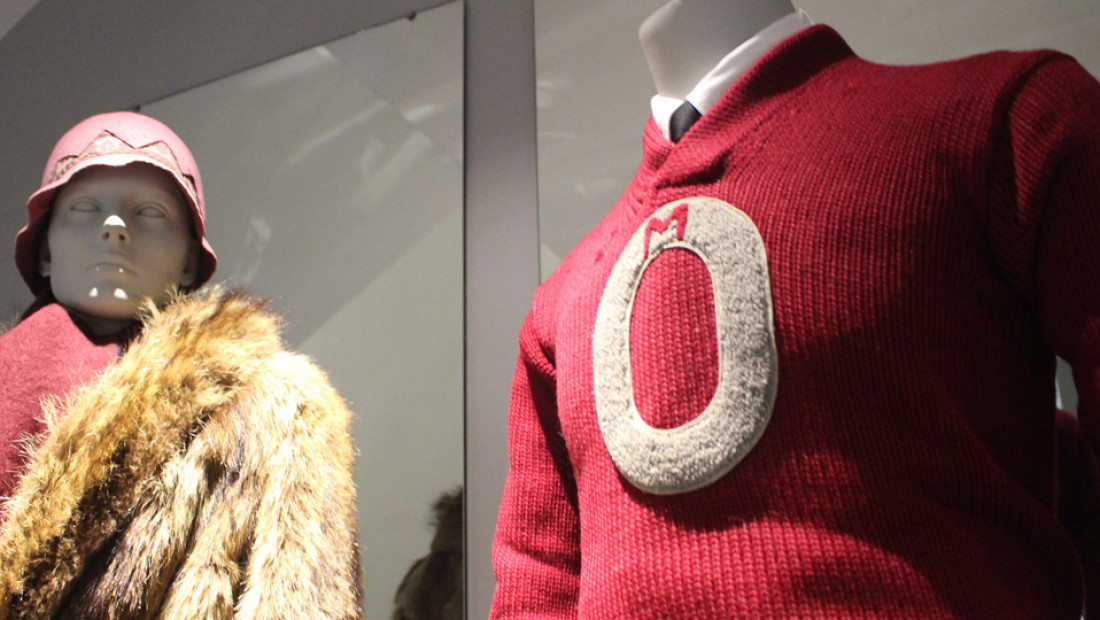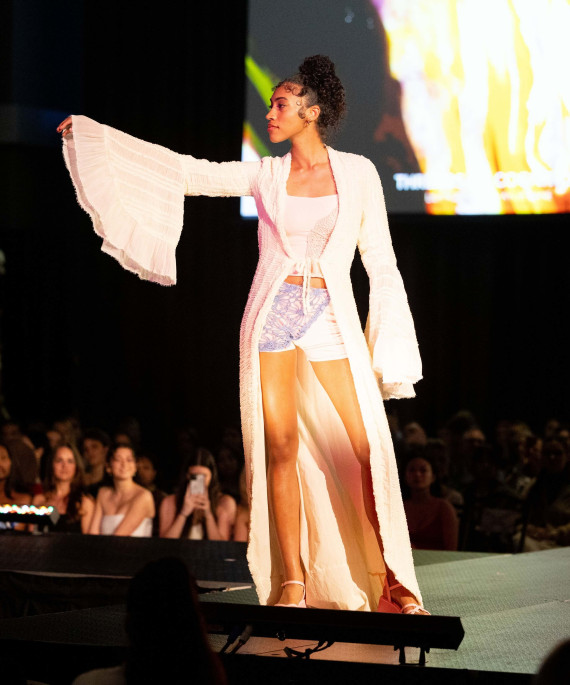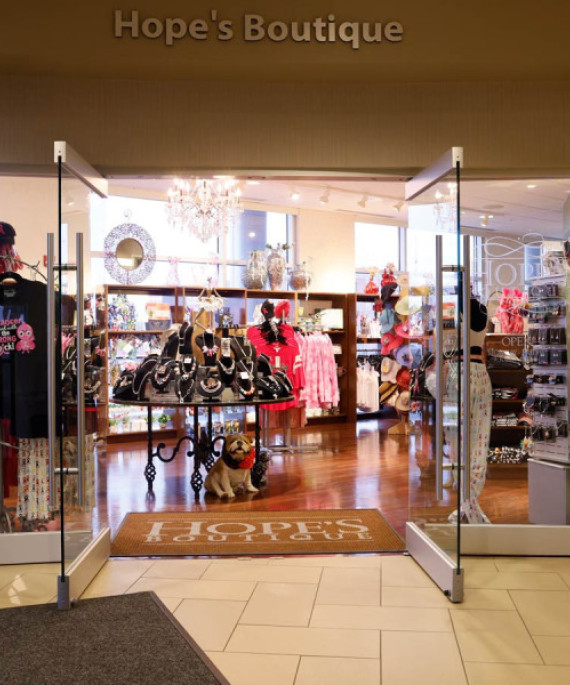
Floyd Henderson earned this Ohio State letter sweater as a manager on the 1928 cross country team. The raccoon fur coat and pink cloche hat were fashion statements of the mid 1920s.
Today’s typical college student often wears distressed skinny jeans, t-shirts and Nike or Converse tennis shoes. But students attending The Ohio State University when it opened in 1870 dressed up in floor-length dresses and suits nearly every day.
From technology to transportation to society as a whole, a lot has changed since Ohio State opened – including fashion. “Campus Fashion: 150 Years of College Style,” the latest exhibit by the college’s Historic Costume and Textiles Collection, highlights how fashion and student life evolved throughout the decades.

“Here in the collection, we're looking at a history of clothing as material culture … and what were some of the social and economic influences that affected the types of clothing that people wore at a given time,” Curator Gayle Strege said.
The upper level of the exhibit serves as a timeline of college fashion, starting in the late nineteenth century and ending in the 1990s. The lower level showcases what students wore for various activities at Ohio State.
Female students of the late 1870s wore floor-length bustle dresses with layers of petticoats beneath, while men wore suit coats — even in summer.
In the early twentieth century, clothing became less formal. Instead of completely covering their bodies, women started showing ankles and arms – a major difference from only a few decades before. The collection’s evening wear exposes shoulders and necklines.

College students today have no problem wearing comfortable clothes in public — even what they slept in the night before. In the late nineteenth century and into the twentieth century, this never would have happened. People of the time, especially women, wouldn’t be caught dead in their lounge wear outside.
“What you wore while you were relaxing in the privacy of your dorm room was not the same clothing that you wore outside to go to class and be in the public environment,” Strege said.
Early in the century, women frequently wore what was called an interior gown when at home. Men wore smoking jackets to relax in their dorms with close friends and family. In the 1920s and ’30s, lounge wear was influenced by Asian culture, with silk pajamas and kimonos making women’s at-home clothing much less formal than an interior gown.
But even students in the early twentieth century had to follow dorm rules, including about their attire. The Men’s Residence Halls Association issued guidelines for apparel. Women followed a much stricter protocol set by Ohio State’s Women’s Residence Hall Council.
The council’s handbook, circa 1957, stated that, “For dinner on school days, including Saturdays,” women must wear dresses or skirts with either blouses or sweaters. “No slacks, bermudas, or jeans. No shirt tails out and no sweatshirts.”
The late ’60s through the ’70s saw major changes in fashion and society as a whole. MaryLou Starr, ’70, was a Textiles and Clothing program major who had designed clothing since she was a child.
When Starr started at Ohio State in 1966, she did not own one pair of jeans. When she went to dinner on campus, she had to wear a skirt. Hemlines were knee length.
Then things relaxed, Strege said. “Jumping into the baby boomer generation you can really see a much greater casualization in clothing,” she said.

Starr recalls the change. “The hemlines changed tremendously. When I first got there, girls were wearing things close to their knees. And by the time I graduated, I could cup my fingers around the hem of my skirt (while standing with her hands at her sides),” she said.
She lived in Baker Hall West before moving into her sorority house. By the time she left her dorm, women were allowed to wear dress pants to dinner.
Starr was a May Queen contestant — part of May Week, an annual celebration started in 1910 to highlight student achievements and the end of the academic year.
“It was kind of like the spring version of homecoming. There were fun activities all week,” Starr said.
As a contestant in 1970, Starr made a white tunic with white lace sleeves paired with white lace pants. The Vietnam War was in full swing, and tensions on campus were running high.
After four students were killed at Kent State University, Ohio State’s campus was shut down. The student body did not have a chance to vote for May Queen, and the celebration became one of the last of May week events at Ohio State.
Starr graduated that fall, but Ohio State was forever changed.

Kathy Copeland, who graduated in 1976, also remembered when she made clothing for a class. Featured in the exhibit is Copeland’s tan, cotton-denim two-piece dress, made for a construction class. She wore the dress as a student teacher.
“I definitely remember getting supplies for that outfit. I did not have a car at the time, so I walked to Joanne Fabrics — which was north of the today’s Schottenstein Center — in the snow!” Copeland said. “I sewed on a tiny desk in my apartment living room with a machine borrowed from my grandmother.”
On the upper level of the museum, the timeline of the exhibit moves into the final decades of the 1900s. A polo shirt and printed jeans represent the 1980s. And nothing says the ’90s like a Nirvana t-shirt, jeans and a vintage flannel that the donor’s dad had worn in the ’70s — every era likes to look back, it seems — paired with Converse shoes.
The exhibit downstairs has different sections, including “Women in White,” which showcases graduation and initiation dresses worn by women inducted into honor societies and sororities. Also featured are international student fashions, clothing made in classes and lab dresses worn by students in food and nutrition labs.
A mannequin couple is decked out for a football game in the 1920s – the man sporting a Block O sweater; the woman, a racoon fur coat.
Styles come and go, but some fashions always seem to make a comeback. Today, college students love ’90s fashions – you can’t go wrong with a scrunchie or a bucket hat and chunky “dad-style” tennis shoes or Doc Martens.
Time and change will surely come, even to the styles students wear. But as the 150 Years exhibit shows, fashion remains a great way to track who we were, and who we have become.




